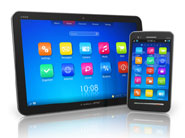NICE has introduced the NICE Mobile Reach (MR) solution, an offering for assisted customer service over smartphones and tablets, which could change how customers use smart mobile devices for interacting with companies.
NICE Mobile Reach allows enterprises to help mobile customers choose the best channel for completing their transaction, enables a seamless and effective transition with context to other channels when necessary, and facilitates multimedia communication between customers and agents during interactions. This offering will create a differentiated customer experience, helping to achieve greater loyalty, higher revenue and lower service costs.
The proliferation of smartphones and tablets is accelerating, and they are quickly becoming the preferred communication device for many consumers. However, when communicating with companies’ service centres, the smartphone is essentially a “dumb phone,” used for just dialling a free number, not utilizing its powerful capabilities and missing the opportunity for a rich and effective experience.
When a customer cannot resolve an issue – due to a problem, missing functionality, a need for clarification, or a regulatory requirement – they are left alone to decide the best option to contact the service provider. Most of those customers decide to call the contact centre, without knowing if that’s their best option.
In such cases, customers are then sent through the interactive voice response system (IVR), having to wait their turn, and then must start from the beginning with the service agent, re-authenticating themselves and explaining what they were trying to accomplish.

Udi Ziv
Udi Ziv, President NICE Enterprise Group, said that, in contrast, “NICE Mobile Reach analyses, in real time, a multitude of data sources from the mobile device and enterprise systems and then recommends for the customer the most suitable channel to continue the interaction when they need assistance.”
“If the customer decides to speak with a contact centre agent, the solution seamlessly connects them with the appropriate representative while bypassing the IVR, and transferring the customer’s intent and context to appear on the agent’s desktop just before the conversation begins, enabling a great, personalized customer experience for the customer, while reducing the call handle time of the agent,” Mr. Ziv continued.
As the customer and agent converse over the phone, multimedia collaboration tools such as text chat, image exchange, and document transfer will be available for both parties, making the interaction effective, increasing conversion rate, and driving quick and complete resolution on first contact.
Michael Maoz, research vice president and distinguished analyst of Gartner, commented, “The mobile channel is emerging as the consumer’s primary choice for all possible service activity with service providers. The use of the mobile channel will accelerate once customers realize that their needs will always be met through this touch point. Complementing mobile self-service with assisted-service is a natural and required evolution of the mobile channel. By adding these capabilities to their existing mobile self-service offering, industries such as banking, travel, telecommunications and retail are able for the first time to provide their customers with a true hybrid service channel that leverages smart mobile devices.”
Author: Jo Robinson
Published On: 2nd May 2012 - Last modified: 22nd Mar 2017
Read more about - Archived Content, NiCE






























